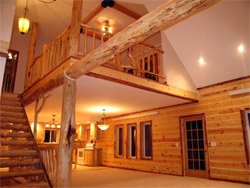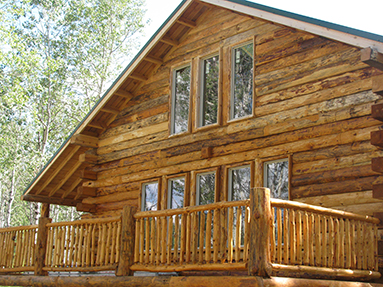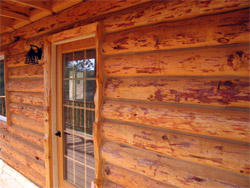Aker Woods: Hand Peeled D-Logs
Our milled house logs have the authentic appearance of a hand-crafted log home because we leave the outer surface unmilled, then we peel it by hand. We can hand-peel the interior surface as well, or mill it flat and finish it to a hand-hewn appearance. Our milled logs don't require any:
Drilling
Support rods
Extensive shaping and carving
Cranes
Systems to compensate for settling from compression and shrinkage
Current Price for Hand-Peeled D Logs: $9.00 per Linear Foot

Zoom
Interior of a home built with our hand-peeled D logs - Ask about our log stairs, interior support posts and beams, and log railings.
|

Zoom
1,680 sq ft home - This is a 36' x 28' house with a 12'-high log wall being built with our 8x8" D-logs. We've left the outside of the house logs un-milled for an authentic log home look. Our D logs are an easy and economical way to build a log home. This log home will have 4 bedrooms, 3 baths, and a log cost of only $19,584.
|

Zoom
Note the genuine hand-peeled exterior of our D logs - Ask about our matching hand-peeled window and door trim.
|
What Log Lengths Should I Order?
We recommend you buy random-length logs. This avoids the need to use the logs in any particular order, and gives you flexibility for changes in windows and doors. Our random-length logs are 7' - 20'. We can provide specified lengths for an additional cost. For most structures, you will need to butt two logs together for long spans above windows and doors.Since our logs are hand-peeled, the logs will not match perfectly, and we recommend grinding the logs to a matching profile after they're bolted down.
How Many Logs Should I Order?
We use this simple formula: If you're using our standard 8"-high logs, calculate the perimet er of the structure, then multiply by 12 for an 8'-high wall and 13 for an 8'8"-high wall. Order that many linear feet of logs.This formula does not account for the window and door openings or for the log "tails" which will extend beyond the corners, or for waste. Almost without fail, these things even out, and use of this formula will give you just a few extra logs left over. (Leftover logs make great sandboxes, garden beds, playhouses, and landscape timbers.)
How Do I Keep My Walls Plumb and Sturdy?
Before you begin, construct an L-shaped straight-edge out of two straight 2"x4"s, and attach them to each corner.Stabilize them by means of a brace that's attached to the sub-floor on the interior of the structure. Build boxes out of 2"x8" lumber for window and door openings, and brace these to the sub-floor as well. Maintain structural sturdiness by avoiding butt joints over the tops of windows and doors and avoiding placing butt joints near other joints on the course of logs below them.
How Do I Fasten the Logs In Place?
For 8"-high logs, we recommend 10" lag bolts made for log home construction. They can be driven with a good drill without any pre-drilling. We recommend 2 bolts on logs under 12' and 3 bolts for longer logs. The bolts are easy to counter-sink, so they don't affect the next course of logs.
How Do I Cut the Logs to Length?
For the most precise cut, we recommend a skill saw attachment called a Prazi Beam-Cutter. You can also cut the logs with a chainsaw by penciling cut lines on the top and inside of the log with a square, then following both lines as you cut. Imprecisions in these cuts can be concealed by window and door trim, and with chinking.
How Do I Seal the Logs?
We recommend chinking the inside, outside, or both sides of the log wall, and make it one of the last things you do on the structure. This gives the logs the maximum amount of time to seal themselves through the small amount of compression you'll get with our logs. If you don't chink, you can lay a sealing tape or regular caulk between each course of logs, and along window and door openings and in corners.
Are There Log Home-Building Courses Available?
We're not as formal as that. We don't have an organized course that we charge for, but we do have a crew that builds homes locally with our logs. We'd love to have you look at our homes, and observe the tools and techniques we use in construction.
|